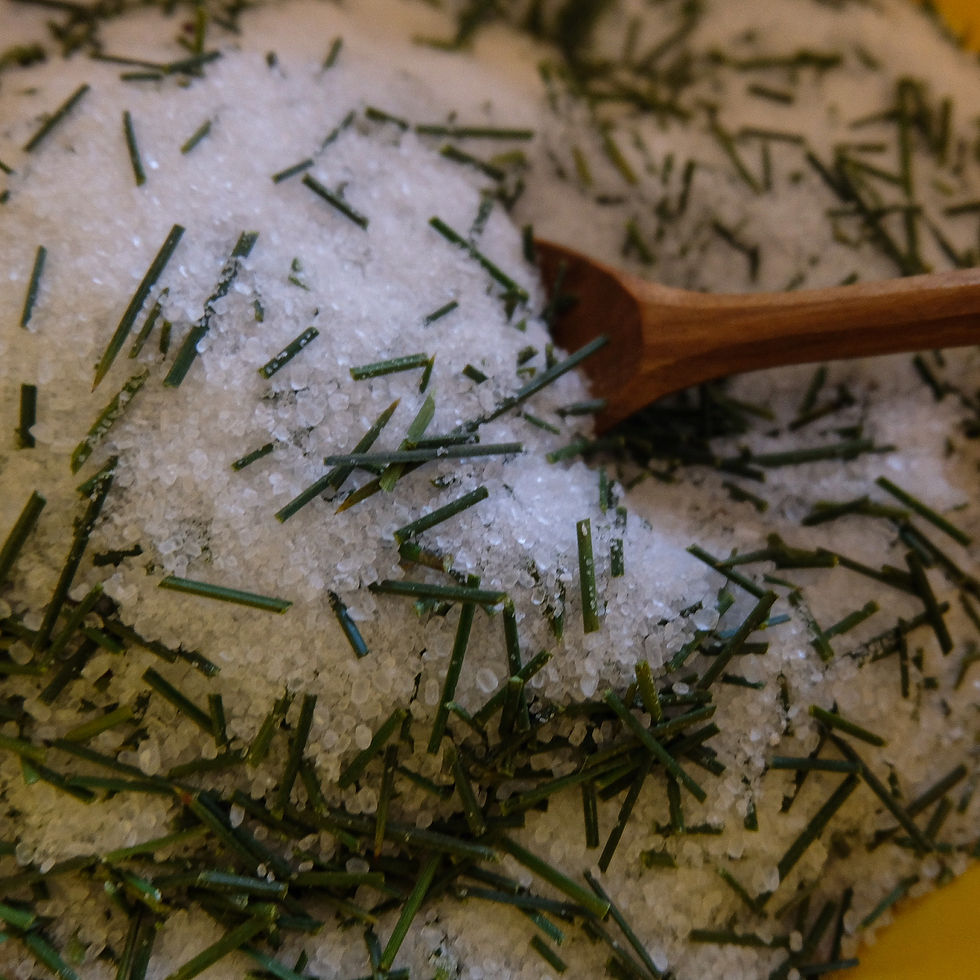- acornsandaprons

- Dec 23, 2022
- 4 min read
Updated: Dec 29, 2022

This DIY gift is a perfect winter treat for yourself or a friend! Use it in baths or hand and foot soaks all winter long! The smell is soothing and earthy! This makes a thoughtful gift for any nature-lover. We included some printable pine bath salts tags - that we made to go with it! Find out how to download it at the bottom of this post.
In the winter we crave greenery and living plants, thankfully evergreens can provide us with that comfort since they stay green all year long. The smell of pine needles gives us the aromatherapy of a rich healthy forest that we crave so much. So, it makes sense soaking in this aroma of pine because it truly helps us reconnect with what we are missing.


Note: some people are allergic to pine needles and can break out into a rash. Most likely they are already aware of their allergy and know to avoid it. You can always do a sample test on your arm, by holding a pine needle against your skin for a few minutes to see what reaction you get before soaking your entire body.


Mix into a large bowl:
Instructions:
2-3 cups Epsom salts
1 cup chopped pine needles (dried or fresh)
Optional:
A few drops of pine essential oil or orange, lemon, tea tree oil etc.
You can add more epsom salt or pine needles, if desired. We found 3:1 cup ratio worked well and makes 2-3 small glass jars.

When you use fresh pine needles it is important to use the bath salts soon after making it. If you add them to the jar fresh - it will add too much moisture and make the bath salts wet, and then it will harden into clumps. We suggest using dried pine needles if you wish to avoid this.
We prefer a combination, we like to cut the pine needles up fresh, that way the oils and aroma can get into the salts. We add them to the large bowl of salt and allow it dry a day or two directly in the salt. Stir the bath salts every once and awhile so it doesn’t collect moisture and harden. You can also lay it out onto a larger cookie sheet to dry.

This picture shows the needles freshly cut:

Here’s two days later, when they have dried. It smells so good, we didn’t have to add any other essential oils!

Foraging for pine needles:
There are over 100 different pine trees. Pine refers to any coniferous tree or shrub belonging to the genus Pinus categorized under the family Pinaceae. Pines are found throughout the world, mainly in the northern temperate regions.
The most definitive feature of pines is that the needles occur in clusters of 2, 3 or 5. A cluster of pine needles is called a fascicle.

It’s best to use branches that have fallen from a tree. Try not to pick directly off of a living tree, as you’ll always find enough that have fallen naturally from storms. If you do need to clip some, use garden clippers or scissors and cut some of the pine needles growing near the bottom of the tree.

Choosing which pine needles to use:
Mostly all pine needles from the various pine trees will work, Just make sure the tree hasn’t been treated. You will also want to avoid poisonous ones, These ones are considered to be toxic; Norfolk island pine, balsam fir, and yew pine (but these three are not really true pines) Ponderosa Pine is not recommended for pregnant women due to the acid found in the oils. Other pine needles, like lodgepole pine can be unsafe for ingesting but would be safe for bath soaks.
Instructions:
Add the salts to a large bowl and chop pine needles (dry or fresh - we preferred fresh). After this, add any essential oil or Vitamins that you may want to include, we found orange essential oil went really well with the pine, chose any essential oils that you like best, if desired. Mix it altogether.
IMPORTANT: Include a cotton or cheese-cloth bag to put the salts into, so that the needles don’t wash down the drain. When it’s time for the bath, place the salts into the bag or a cloth. You can opt out of using chopped pine needles and just use essential oils. You can also use the bath salts for foot baths in a small portable tub (container) and pour it outside when finished. Alternatively, you can use a plug that catches everything before it goes down the drain.
Run your bath as hot as you’d like it. Then, add half of a cup, up to two cups of the bath salts to your bath, allow it to absorb under the faucet and really get into the bath water! Soak in the bath for 20 mins and Enjoy!

Benefits:
Pine needle oil is also high in vitamin A, which is an essential nutrient needed to keep skin, hair, eyes, and nails healthy. It also contains vitamin C. It is said that the pine aromatherapeutic benefits are ideal for people who are sick with a common cold - or stressed and need to relax.

Add your mixed bath salts and pine needles to small jars, like a recycled glass jam jar. Then add a fun label (like the ones we made) and give them as gifts this winter.

We also create little clay and pine needle ornaments to go with the jars!


We hope you have fun foraging pine needles and making this lovely pine needle bath salt! If you create this craft by Acorns and Aprons, feel free to share It and tag us @acorns.and.aprons on Instagram and we will share this DIY craft to our stories.
You can download the Pine Bath Salts labels here:











Comments